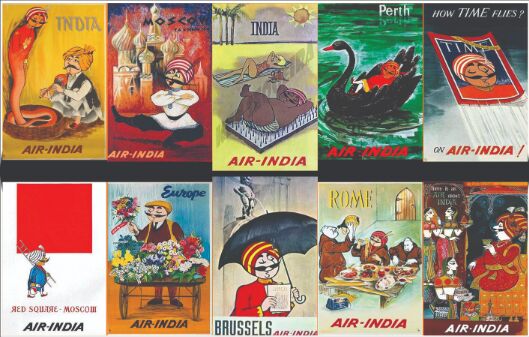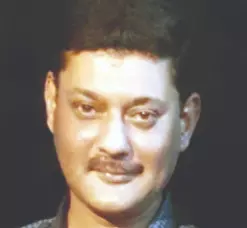Will the Maharaja reign again?
Being familiar with the Tatas, I am confident that the famous moustache shall be waxed once more, making Air-India the world's benchmark airline yet again

I see hope now. I see chances of a revival. There are strong expectations today that what the merger of Air-India and Indian Airlines took away from the sheen of the Maharaja may finally be reversed by the new management under the Tata Group," said one who ran the airline as its chief many moons back. That set me thinking – will the adored and revered Maharaja reign once again? Personally, I am confident that he will, for I have been lucky enough to have been connected with the Tatas for years, having worked closely with the Board of Directors. The work ethic, transparency, efficiency and discipline of this group is world-best, second to none other. And that's saying very little of what they have stood for, for a century-and-a-half and more.
Let's factor in the fact that it was Tata Sons that started the airline in 1932; today, thus, there is a point to prove by the creators themselves. Here's some history – Air-India began as Tata Air Services and was subsequently rechristened as Tata Airlines, founded by none other than the legendary JRD Tata, an enthusiastic Indian aviator and an outstanding business tycoon. In April of that first year itself, the Tatas won a contract to carry mail for Imperial Airways on two single-engine de Havilland Puss Moth aircraft. On 15 October of the same year, JRD Tata personally flew a Puss Moth carrying air mail from Karachi to Bombay (now Mumbai). The aircraft didn't rest for too long, for it flew on to Madras (now Chennai), piloted by Nevill Vintcent, a former Royal Air Force pilot and JRD's close friend.
At this time, the airline boasted of a Puss Moth aircraft and a de Havilland Leopard Moth, Wikipedia informs me. Initial offerings included weekly airmail services between Karachi and Madras via Ahmedabad and Bombay. In its first year of operations, the airline flew 260,000 km, carrying 155 passengers and 10.71 tons of mail, making a then handsome profit of Rs 60,000.
Came nationalization…
In 1953, Tata Airlines, the cynosure of all eyes and a shining beacon in the international aviation sector, was taken over by the Government of India, under the aegis of then Prime Minister Pandit Jawaharlal Nehru. The Government passed the Air Corporations Act and purchased a majority stake in the carrier from Tata Sons and JRD, as he was fondly called. The company was renamed Air-India International Ltd and its domestic services were transferred to Indian Airlines as a part of a restructuring, with JRD set to continue as Chairman till 1977. Already, international services to Nairobi and major European destinations like Rome, Paris and Düsseldorf had taken off. The airline also took delivery of its first Lockheed Constellation aircraft and began flights to Bangkok, Hong Kong, Tokyo and Singapore.
In 1960, Air-India International inducted its first Boeing 707, becoming the first Asian airline to enter the Jet Age. The airline kicked off services to New York in May 1960. In June 1962, the airline's name was officially truncated to Air-India. In the same month, it became the world's first all-jet airline. That was 'Shining India'. Indeed. In 1971, the airline took delivery of its first Boeing 747-200B, named it 'Emperor Ashoka' and introduced a new 'Palace in the Sky' class of travel, unheard of anywhere in the world. In 1986, Air-India took delivery of an Airbus A310; in 1993, it took over the controls of a Boeing 747-400 named 'Konark' and operated the first non-stop flight between New York and Delhi.
An incredulous new era was born. As a former Chairman and Managing Director of the airline told me with unabashed pride, carriers like Singapore Airlines, Cathay Pacific and Thai Airways sent senior executives for decades to understand just what it was that made Air-India the best in the world. The Tatas had created yet another global best.
Then came the fall
It was too good to be allowed to last, it seems. While liberalization worked well for most parts of the Indian economy, including aviation, things didn't work out too well for our Maharaja. Starting with Year 2001 and the new millennium, Air-India began showing cracks borne out of years of financial ruthlessness, sadism and neglect, cracks that turned into gaping holes in its balance sheet. Even as attempts were made by the Government to re-privatize the airline and it introduced services to Shanghai, the Ministry of Civil Aviation charged a serving Managing Director with corruption.
The saga continued and the red ink leaked like never before on the balance sheet. The airline reportedly lost Rs 57 crore in Year 2001, allegedly because of additional commissions that the then-management sanctioned; the then-MD was suspended. In May 2004, Air-India launched a low-cost subsidiary called Air-India Express, connecting cities in India with the Middle-East and South-East Asia. Until 2007, Air-India predominantly plied on international long-haul routes, while Indian Airlines operated on domestic and international short-haul routes.
In 2007, Air-India and Indian Airlines were merged, with the airline becoming part of the Star Alliance. That's when the rot truly set in. The combined losses of Air-India and Indian Airlines in FY 2006-07 were Rs 770 crore. After the merger, it went up to Rs 7,200 crore by March 2009. Year 2009 saw the appointment of State Bank of India to prepare a roadmap for a turnaround, with Air-India selling four aircraft to re-finance the mounting debt. By 2011, Air-India had accumulated red ink of Rs 42,600 crore and operating losses of Rs 22,000 crore. Even as it sought Rs 42,900 crore from the Government, the Comptroller and Auditor General (CAG) blamed the decision to buy 111 new aircraft and the merger with Indian Airlines for the financial crisis.
The Maharaja's famous moustache buckled, as did his knees.
Come in the Tatas
As a former chief of the airline told me a few hours back (as I was writing this column), there's finally new-found hope. And that's because the Tatas are back in the scheme of things. This Group has an enviable record of turning around companies that have been written off by all else. Who can forget what they managed with TISCO, TELCO and Indian Hotels, turning near-empty shells into extremely successful and global-best brands? In recent times, what the Tatas have done with automotive icon Jaguar and Land Rover, and then with their own stable of vehicles under the Tata Motors brand, is astounding. As a professional, I stand chastised and dumbstruck. The Tatas are what they are.
I would be remiss of me not to congratulate the Government of India (which I have questioned a few times on some issues) for reaching this landmark deal and taking a bold step towards maintaining our national pride. Air-India has always been a source of pleasure, for it contains the word 'India'. I say this despite the fact that in my last flight on the airline, the arm-rest came off unrequited and the food was quite unpalatable. Sometimes, things get bad, worse and despicable before the brave enter to turn things around. I and 135-plus crore Indians find succor in this thought. I believe that the Maharaja is already waxing his whiskers. And this red-adorned Maharaja shall be back, I am quite sure, for he is being shepherded and guided by the one person who has astounded and enamored lakhs and lakhs of us, if not more.
Hear this, please. Entering Parliament House in Delhi 10 years back, Sir Ratan Tata spotted me lurking somewhere in the shadows. He walked up to me and asked: "How are you doing, Rajeev?" Standing six-feet tall, I almost fell down to nothingness. Why did he remember me and my name, for he had met me only once, six years ago? I learnt a lesson that day. The memories of the blessed and truthful run very deep; just as I am sure that Sir Ratan Tata's memories of JRD founding Tata Air Services and Tata Airlines (now Air-India) run way deeper.
The writer is a communications consultant and a clinical analyst. [email protected]. Views expressed are personal



